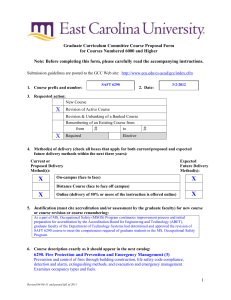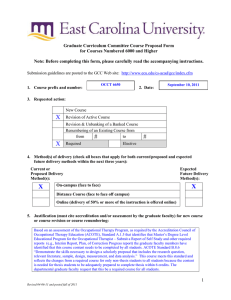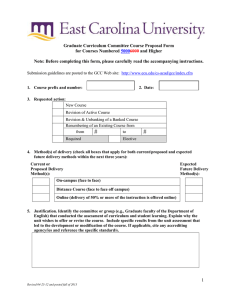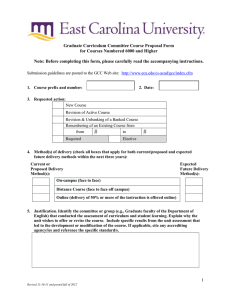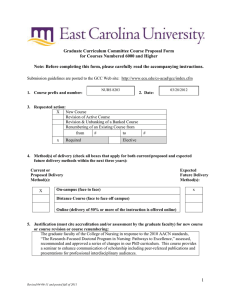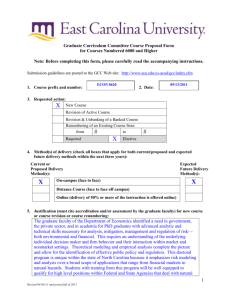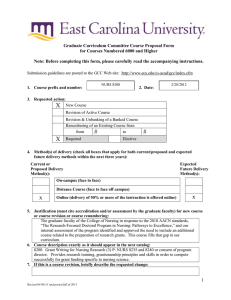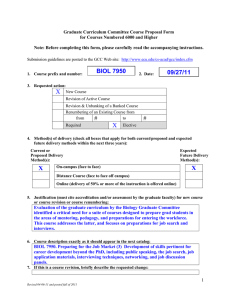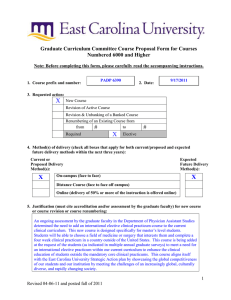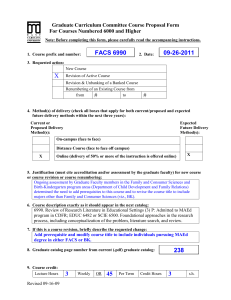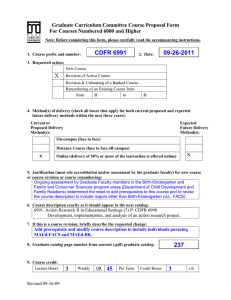Document 15476421
advertisement
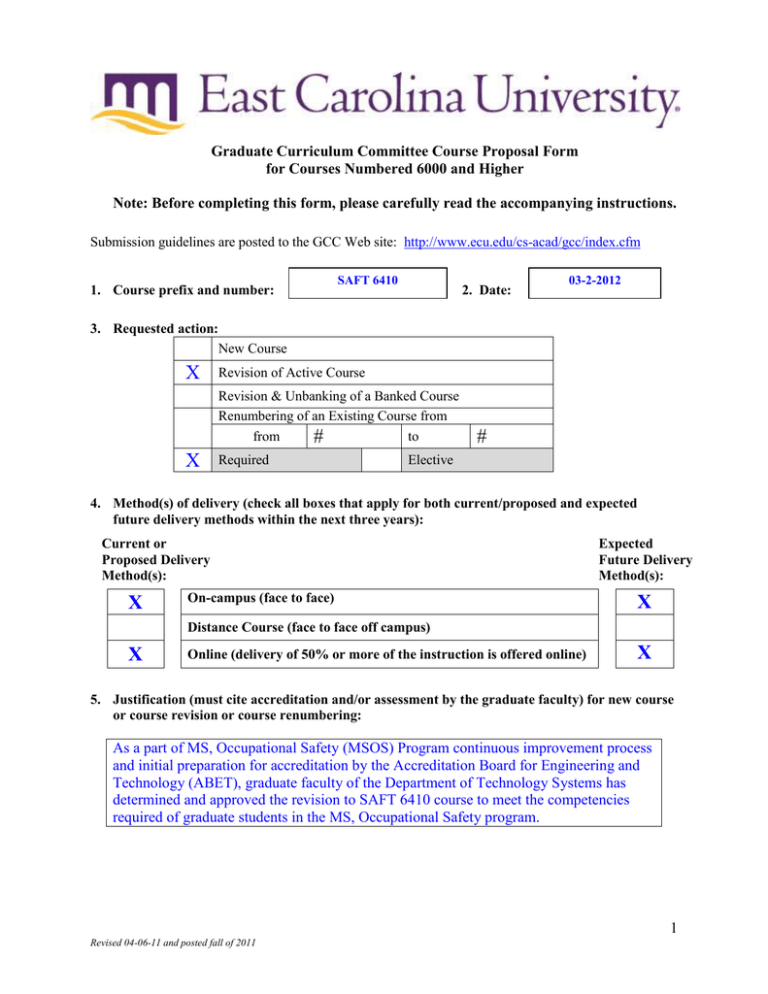
Graduate Curriculum Committee Course Proposal Form for Courses Numbered 6000 and Higher Note: Before completing this form, please carefully read the accompanying instructions. Submission guidelines are posted to the GCC Web site: http://www.ecu.edu/cs-acad/gcc/index.cfm 1. Course prefix and number: SAFT 6410 2. Date: 03-2-2012 2. 3. Requested action: New Course X Revision of Active Course Revision & Unbanking of a Banked Course Renumbering of an Existing Course from from to # X Required # Elective 4. Method(s) of delivery (check all boxes that apply for both current/proposed and expected future delivery methods within the next three years): Current or Proposed Delivery Method(s): X On-campus (face to face) Expected Future Delivery Method(s): X Distance Course (face to face off campus) X Online (delivery of 50% or more of the instruction is offered online) X 5. Justification (must cite accreditation and/or assessment by the graduate faculty) for new course or course revision or course renumbering: As a part of MS, Occupational Safety (MSOS) Program continuous improvement process and initial preparation for accreditation by the Accreditation Board for Engineering and Technology (ABET), graduate faculty of the Department of Technology Systems has determined and approved the revision to SAFT 6410 course to meet the competencies required of graduate students in the MS, Occupational Safety program. 1 Revised 04-06-11 and posted fall of 2011 6. Course description exactly as it should appear in the next catalog: 6410. Systems Safety and Risk Analysis (3) P/C: SAFT 6001 or consent of instructor. Applications-oriented study of recognition, assessment, and evaluation of risks in occupational environment. Formulation of control systems for alleviation of accidents and injuries. 7. If this is a course revision, briefly describe the requested change: Risk assessment techniques have been included. 8. Course credit: Lecture Hours 3 3 Weekly OR Per Term Credit Hours Lab Weekly OR Per Term Credit Hours s.h. Studio Weekly OR Per Term Credit Hours s.h. Practicum Weekly OR Per Term Credit Hours s.h. Internship Weekly OR Per Term Credit Hours s.h. Other (e.g., independent study) Please explain. s.h. s.h. 3 Total Credit Hours s.h. 15 9. Anticipated annual student enrollment: 10. Changes in degree hours of your programs: Degree(s)/Program(s) Changes in Degree Hours MSOS Program None 11. Affected degrees or academic programs, other than your programs: Degree(s)/Program(s) Changes in Degree Hours Security Studies None 12. Overlapping or duplication with affected units or programs: Not applicable Documentation of notification to the affected academic degree programs is X attached. 13. Council for Teacher Education (CTE) approval (for courses affecting teacher education): X Not applicable Applicable and CTE has given their approval. 14. University Service-Learning Committee (USLC) approval: X Not applicable Applicable and USLC has given their approval. 2 Revised 04-06-11 and posted fall of 2011 15. Statements of support: a. Staff Current staff is adequate X Additional staff is needed (describe needs in the box below): b. Facilities X Current facilities are adequate Additional facilities are needed (describe needs in the box below): c. Library X Initial library resources are adequate Initial resources are needed (in the box below, give a brief explanation and an estimate for the cost of acquisition of required initial resources): d. Unit computer resources X Unit computer resources are adequate Additional unit computer resources are needed (in the box below, give a brief explanation and an estimate for the cost of acquisition): e. ITCS resources X ITCS resources are not needed The following ITCS resources are needed (put a check beside each need): Mainframe computer system Statistical services Network connections Computer lab for students Software Approval from the Director of ITCS attached 16. Course information (see: Graduate Curriculum and Program Development Manual for instructions): a. Textbook(s) and/or readings: author(s), name, publication date, publisher, and city/state/country. Include ISBN (when applicable). Richard A. Stephans (2004). System Safety for the 21st Century. John Wiley and Sons, Inc., New Jersey. ISBN 0-471-44454-5 Readings from selected literature 3 Revised 04-06-11 and posted fall of 2011 b. Course objectives for the course (student – centered, behavioral focus) Upon completion of this course, students will be able to: Apply concept of risk analysis and its applications in occupational and environmental settings; Perform system safety job hazard analysis; Identify and analyze potential hazards using selected system safety analytical techniques; Apply adequate models to quantify the probability of risks; Develop a comprehensive plan to identify and control system hazards within facilities. c. Course topic outline 1. Fundamentals of System Safety 2. Concepts and Approaches to System Safety. 3. System Safety Products (SSPP, PHL, PHA, SHA, OHA, CAR, AAR) 4. Analytical trees and their applications. 5. Risk Assessment Process. 6. Energy Trace and Barrier Analysis 7. Failure Mode and Effect Analysis 8. Fault Tree Analysis 9. Project Evaluation Tree 10. Change Analysis 11. Management Oversight and Risk Tree 12. Event and Causal Factors Charts and Models 13. Prevention Through Design d. List of course assignments, weighting of each assignment, and grading/evaluation system for determining a grade Assignments: Quizzes........................ 40% Team Project ............... 30% Lab Assignments......... 30% Grading: 100%-90% .................. A 89.9%-80% ................. B 79.9%-70% ................. C 69.9%-0 ....................... F 4 Revised 04-06-11 and posted fall of 2011
